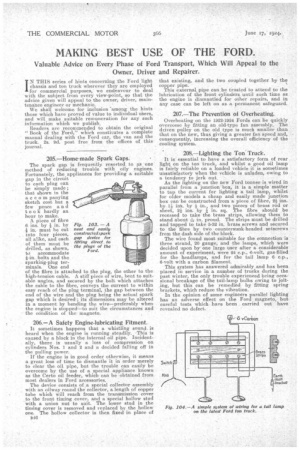MAKING BEST USE OF THE FORD.
Page 30

If you've noticed an error in this article please click here to report it so we can fix it.
Valuable Advice on Every Phase of Ford Transport, Which Will Appeal to the Owner, Driver and Repairer.
IN THIS series of hints concerning the Ford light chassis and ton truck wherever they are employed for commercial purposes, we endeavour to deal with the subject from every view-point, so that the advice given will appeal to the owner, driver, main
tenance engineer or mechanic. . We shall welcome for inclusion 'among the hints those which have proved of value to individual users, and will make suitable remuneration for any such information which we publish. Readers are recommended to obtain the original "Book of the Ford," which constitutes a complete manual dealing with the Ford car, the van and the truck. 2s. 9d. post free from the offices of this journal.
205.—Home-made Spark Gaps.
The spark gap is frequently resorted to as one method of reducing trouble with oily engines. Fortunately, the appliances for providing a suitable gap in the circuit to each plug can be simply made ; that shown in the ace om panying sketch cost but a few pence an d took hardly an hour to make.
A piece of fibre 6 ins, by in. by in. must be cut into four pieces, all alike, and each of them must be drilled, as shown, ti accommodate i-in. bolts and the sparking-plug terminals. One end of the fibre is attached to the plug, the other to the high-tension cable. A stiff piece of wire, bent to suitable angles, and secured by the bolt which attaches the cable to the fibre, conveys the current to within easy reach of the plug terminal, the gap between the end of the wire and the plug being the actual spark gap which is desired its dimensions may be altered in a moment by bending the wire—preferably when the engine is stopped—to suit the circumstances and the condition of the magneto. Fig. 103.—A neat and easily constructedvark gap device for fitting direct to the plugs of the Ford.
206.—A Safety Engine-lubricating Fitment.
It sometimes happens that a whistling sound, is heard when the engine is running steadily. This is caused by a block in the internal oil pipe. Incidentally, there is usually a loss of compression on cylinders Nos. 1 and 2 and a decided falling off in the pulling power.
If the engine is in good order otherwise, it means a great loss of time to dismantle it in order merely to clear the oil pipe, but the trouble can easily be overcome by the use of a special appliance known as the Certo oil feeder, which can be obtained from most dealers in Ford accessories.
The device consists of a special collector assembly with an oilway round the collector, a length of copper tube which will reach from the tranSmission cover to the front timing cover, and a special hollow stud with a union nut to suit. The lower stud in the timing cover is removed and replaced by the hollow one. The hollow collector is then fixed in place of B46 that existing, and the two coupled together by the copper pipe.
This external, pipe can be trusted to attend to the lubrication of the front cylinders until such time as the engine is dismantled for other repairs, and in any case can be left on as a permanent safeguard.
207.—The Prevention of Overheating.
Overheating on the 1922-1924 Fords can be quickly overcome by fitting an old-type fan assembly. The driven pulley on. the old type is much smaller than that on the new, thus giving a greater fan speed and, consequently, increasing the overall efficiency of the cooling system.
208.—Lighting the Ton Truck.
It is essential to have a satisfactory form of rear light on the ton truck, and whilst a good oil lamp is fairly reliable on a loaded vehicle it is sometimes unsatisfactorY when the vehicle is unladen, owing to a tendency to jerk out,
As the lighting on the new Ford tanner is wired in parallel from a junction box, it is a simple matter to tap the current for lighting a tail lamp? whilst for older models a cheap and easily made junction box can be constructed from a piece of fibre, 2i ins. by i int. by 42 in., and two pieces of brass rod or
sheet, 2.i ins, by in. sq. The fibre should be recessed to take the brass strips, allowing them to stand about in. proud. The strips must be drilled and tapped to take 5-32 in. brass screws and secured to the fibre by two countersunk-headed setscrews from the dash side of the block.
The wire found most suitable for the connection is three strand, 20 gauge, and the lamps, which were decided upon by one large user after a considerable amount of experiment, were 24 cp., -6-volt, gas-filled for the headlamps, and for the tail lamp 6 c.p., 6-volt with a carbon filament.
This system has answered admirably and has been placed in service in a number of trucks during the past winter, the only trouble experienced being occasional breakage of the tail-lamp bulbs owing to jolting, but this can be remedied by fitting spring brackets, which reduce the vibration.
In the opinion of some engineers parallel lighting has an adverse effect on the Ford magneto, but careful tests which have been . carried out have revealed no defect.
































